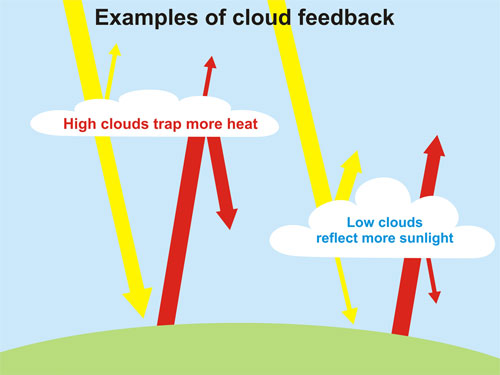A Positive Outlook For Clouds
Posted on 29 December 2010 by dana1981
The effect of clouds in a warming world is a difficult one to predict. One challenge is that clouds have both warming and cooling effects. Low-level clouds in particular tend to cause a cooling effect by reflecting sunlight, while high-level clouds tend to cause a warming effect by trapping heat.

So as the planet warms, clouds can have a cooling effect if the amount of low-level clouds increases and/or if the amount of high-level clouds decreases. Clouds will have a warming effect if the opposite is true. Thus it becomes complicated to figure out the overall effect of clouds, because scientists need to determine not only if the amount of clouds increases or decreases in a warming world, but which types of clouds are increasing or decreasing.
For climate scientists who are skeptical that anthropogenic greenhouse gas emissions will cause a dangerous amount of warming, such as Richard Lindzen and Roy Spencer, their skepticism hinges mainly on this cloud cover uncertainty. They tend to believe that as the planet warms, low-level cloud cover will increase, thus increasing the overall reflectiveness of the Earth, offsetting the increased greenhouse effect and preventing a dangerous level of global warming from occurring. However, some recent scientific studies have contradicted this theory.
Most of the cloud feedback uncertainty is due to cloud changes near the equator, in the tropics and subtropics (Stowasser et al. 2006). Studies by Lauer et al. (2010) and Clement et al. (2009) both looked at cloud changes in these regions in the east Pacific, and both concluded that based on a combination of ship-based cloud observations, satellite observations, and climate models, the cloud feedback in this region appears to be positive, meaning more warming.
Dessler (2010) used cloud measurements over the entire planet by the Clouds and the Earth’s Radiant Energy System (CERES) satellite instruments from March 2000 to February 2010 to attempt to determine the cloud feedback. Dessler concluded that although a very small negative feedback (cooling) could not be ruled out, the overall short-term global cloud feedback is probably positive (warming), and may be strongly positive. His measurements showed that it is very unlikely that the cloud feedback will cause enough cooling to offset a significant amount of human-caused global warming.
So while clouds remain a significant uncertainty and more research is needed on this subject, the evidence is building that clouds will probably cause the planet to warm even further, and are very unlikely to offset a significant amount of human-caused global warming. It's also important to remember that there many other feedbacks besides clouds, and there is a large amount of evidence that the net feedback is positive and will amplify global warming.
This post is the Basic rebuttal (written by Dana Nuccitelli [dana1981]) of the skeptic argument "Clouds Provide Negative Feedback". There is also an Intermediate version which is based on the recent blog posts 'A Cloudy Outlook for Low Climate Sensitivity' and 'An Even Cloudier Outlook for Low Climate Sensitivity'.































 Arguments
Arguments























 0
0  0
0






Comments